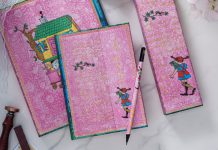Have you ever wondered where the celebrated art of still life painting came from?
Before still life emerged, there were illustrators who delicately illuminated handwritten manuscripts with images of plants, fruits, flowers, animals, and insects to add emotional power to a written work.
One of the most celebrated practitioners of this style of illumination was Joris Hoefnagel (1542–1601). Hoefnagel, a pivotal artistic figure from the Netherlands, is remembered as being the last important Flemish manuscript illuminator and one of the first artists to work on the new genre of still life.
In the 1590s the Emperor Rudolf II commissioned Hoefnagel to add his illuminations to the Mira calligraphiae monumenta, a mid-16th-century manuscript on the art of calligraphy by Georg Bocskay. The page reproduced for our new Pink Carnation design is known as Damselfly, Carnation, Insect, Caterpillar, Ladybird, English Walnut, and Marine Mollusk owing to the abundance of sophisticated flora and fauna so wonderfully illustrated. The scientific naturalism of Hoefnagel’s botanical and animal drawings served as a model for future Netherlandish still life artists.
The Mira calligraphiae monumenta (Model Book of Calligraphy) is regarded as one of the last important examples of European manuscript illumination. Today, the book that inspired our Mira Botanica series can be found in the Getty Museum.
Pink Carnation is available as an ultra, midi, and mini softcover Flexi notebook.





